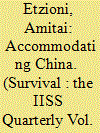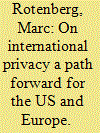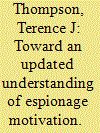| Srl | Item |
| 1 |
ID:
119766


|
|
|
| 2 |
ID:
132564


|
|
|
|
|
| Publication |
2014.
|
| Summary/Abstract |
Low earth orbit has become increasingly congested as the satellite population has grown over the past few decades, making orbital debris a major concern for the operational stability of space assets. This congestion was highlighted by the collision of the Iridium 33 and Cosmos 2251 satellites in 2009. This paper addresses the current state of orbital debris regulation in the United States and asks what might be done through policy change to mitigate risks in the orbital debris environment. A brief discussion of the nature of orbital debris addresses the major contributing factors including size classes, locations of population concentrations, projected satellite populations, and current challenges presented in using post-mission active debris removal to mitigate orbital debris. An overview of the current orbital debris regulatory structure of the United States reveals the fragmented nature of having six regulating bodies providing varying levels of oversight to their markets. A closer look into the regulatory policy of these agencies shows that, while they all take direction from The U.S. Government Orbital Debris Mitigation Standard Practices, this policy is a guideline with no real penalty for non-compliance. Various policy solutions to the orbital debris problem are presented, ranging from a business as usual approach to a consolidated regulation system which would encourage spacecraft operator compliance. The positive aspects of these options are presented as themes that would comprise an effective policy shift towards successful LEO conservation. Potential economic and physical limitations to this policy approach are also addressed.
|
|
|
|
|
|
|
|
|
|
|
|
|
|
|
|
| 3 |
ID:
132535


|
|
|
|
|
| Publication |
2014.
|
| Summary/Abstract |
The United States and its closest allies may be on a collision course over the future of privacy in the networked world. Whether leaders are able to find a policy solution will require that they understand the significance of the recent NSA disclosure as well as the development of modern privacy law. Long before a former NSA contractor spilled the secrets about the scope of the NSA's global surveillance, foreign governments worried about the ability of the United States to monitor those living in their countries. The increasing automation of personal information and the technological advantage that the United States enjoyed over other nations was already seen as a problem in the late 1960s. The concerns only increased as Internet-based commerce gave rise to the vast collection and storage
|
|
|
|
|
|
|
|
|
|
|
|
|
|
|
|
| 4 |
ID:
130228


|
|
|
|
|
| Publication |
2014.
|
| Summary/Abstract |
The case of Edward Snowden, who in May 2013 revealed a huge number of National Security Agency codes, has again raised the question of motivation in espionage and disclosure of documents.
Espionage is a crime with complex, multi-faceted motivational factors that do not lend themselves to easy explanation. Most cases present a singular mosaic of intersecting psychosocial forces which culminate in a decision to engage in the crime. Espionage is committed by individuals from the lower middle to upper middle classes; unlike street crime, it is rarely, if ever, committed by the poor. What drives people of middle class privilege to choose to commit such a heinous crime?
The current model, postulated by numerous scholars and simplified here, holds that espionage occurs at the collision of an opportunity, a perceived life crisis, and a moral failing, which is then actuated by a trigger. 1 The spy must have an opportunity, which usually translates into access to information or a person. Access to information is typically gained through the holding of a security clearance. Such a trusted insider has minimally restrained access to classified information, and that access is usually defined by position. A senior scientist working on satellite systems obviously has significant access to classified satellite data but may have almost no access to human intelligence (HUMINT)-and vice versa. Conversely, and perhaps surprisingly, according to one study, 25 percent of known spies since World War II have held no security clearance. 2 These spies usually acted in concert with another individual (often a spouse or lover), or simply knew someone who did have access. This was the case in the Boyce-Lee case in California wherein Christopher Boyce held a security clearance and Dalton Lee did not. 3 Access, however derived, represents the most common opportunity to commit espionage.
|
|
|
|
|
|
|
|
|
|
|
|
|
|
|
|